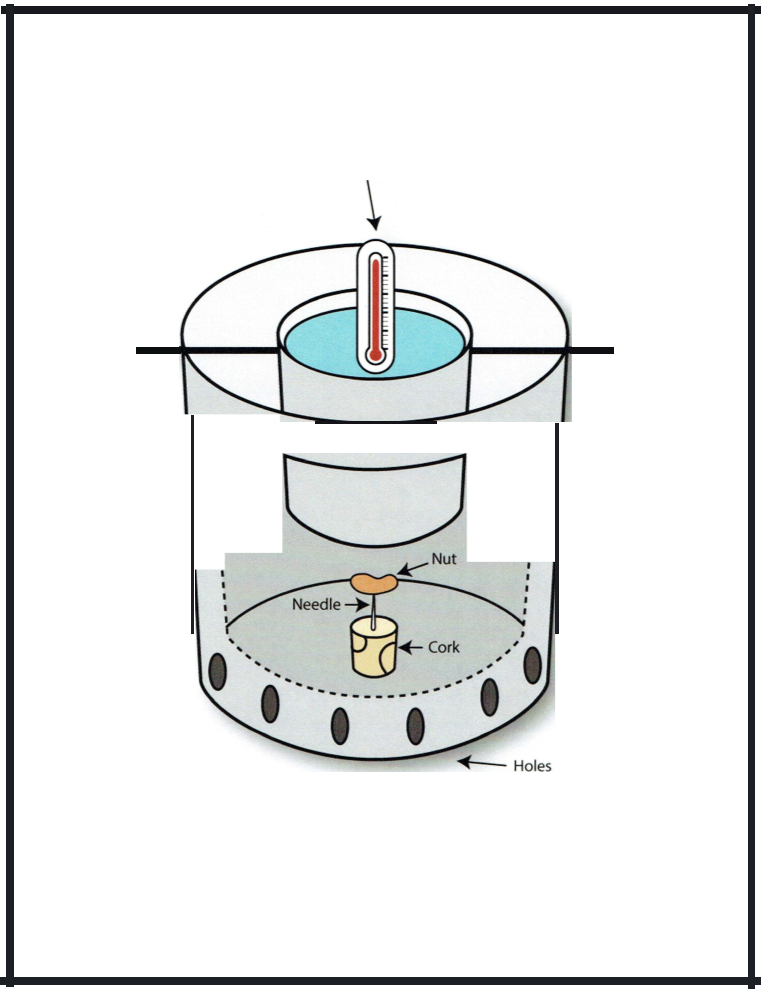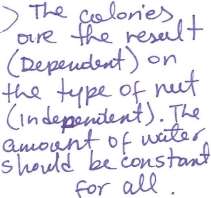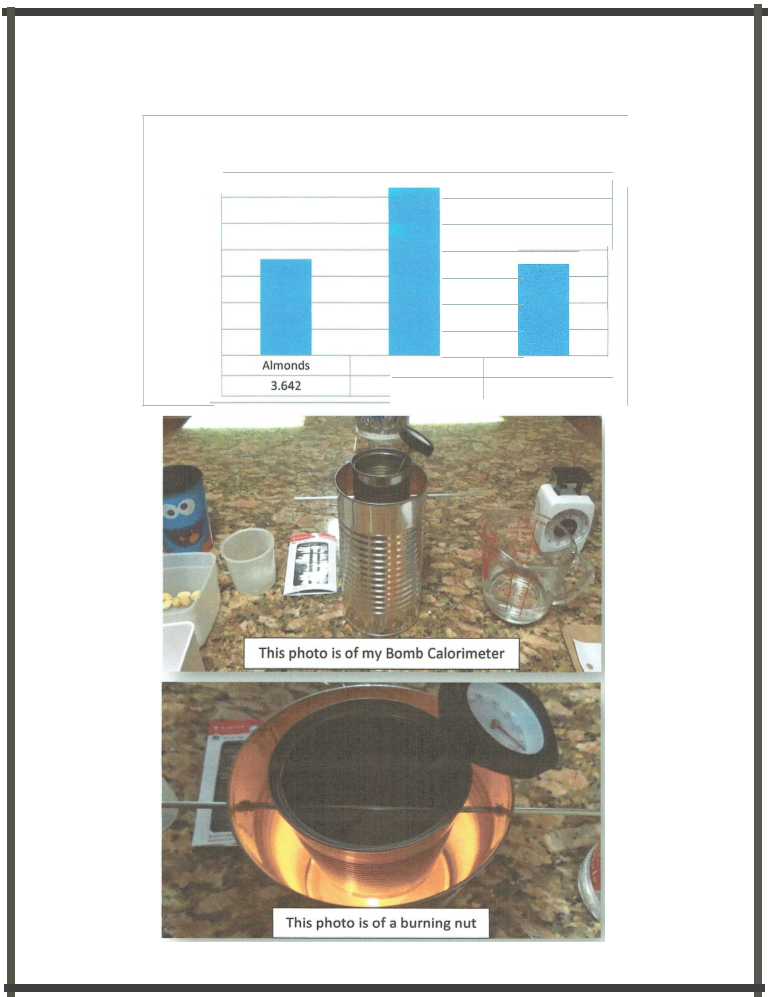
Bomb Calorimeter Experiment

There are different amounts of Calories in the types of food that you eat every day. So I wanted to find out how many Calories are in three different kinds of nuts so, I discovered the Bomb Calorimeter. I will be using the Calorimeter to find out the amount of Calories for the nuts. The purpose of this experiment is to find out how many food Calories are in a cashew, almond, and peanut. I will also be finding out which type of nut contains the most amount of Calories on average.
A Bomb Calorimeter is a device that uses heat to find out how many Calories are in foods but in this case it will be used to find out how many Calories are in these nuts. There are two different kinds of calories the first type is a normal calorie with a lower case c that is the amount of energy needed to heat 1gram of water to 1°F. The other type of calorie is with an upper case C,this Calorie is equal to 1000 normal calories and are called Kilo Calories or Food Calories. I believe that the cashew will contain the most amount of energy and Calories because of the oils that the cashew produces
The bomb calorimeter is made up of a large and small tin can, a metal rod, a cork and a needle. I will also need a thermometer that measures in Fahrenheit, a food scale capable of measuring in grams, a measuring cup, and 10 of each nut. I used these materials to create the calorimeter by opening up the top and bottom of the large can and opening only the top of the smaller can. Then I hammered in 2 holes equal to each other in the bigger and small can. Then I stuck the metal rod through each of these holes. Then I opened up 8 holes on the bottom of the can and placed the blunt side of the needle into the cork. To do this experiment I poured half a cup of water (118 grams) into the smaller can and placed the nut on top of the needle. Then I lit the nut on fire and quickly placed the cans over the nut. I took the temperature of the water before and after I did the experiment to find the change in temperature which is an important part of my experiment. The variable for my experiment are: the type of nut as the Independent Variable, the amount of water used for each trial as the Dependent Variable, and the amount of Calories for each nut as the Constant Variable.
Since the nuts were too light to weigh on their own I had to weigh all10 of the nuts at once and find the average. Then once I finished my experiment and found the difference in temperature for all the trials I found the average. Then to find the average amount of Food Calories I divided the change in temperature by the amount of water in grams . The average amount of Food Calories was: peanuts- 3.48, almonds- 3.642 and cashews- 6.36. In the end I had proved my hypothesis where I stated that the Cashews would have the most amount of Food Calories due to the amount of oil in the nut.
Introduction
Have you ever wondered how many Calories are in the types foods you eat every day? For this experiment I will be using use a Bomb Calorimeter which uses heat to find out the amount of Calories in the food item. The purpose of this experiment will be to find out how many Food Calories are in certain foods. I will be building my own Bomb Calorimeter out of tin cans and I will be testing out 3 different kinds of nuts. These nuts are almonds, cashews, and peanuts. The end objective of this experiment will be to find the average amount of Calories in each nut.
Hypothesis/Research
In this experiment I will not be eating the nuts but instead I will be using calorimetry. Calorimetry is the science of measuring through heat, in Latin the word “calor” means heat and “metry” means measure. Calorimetry is also the measurement of the amount of heat exchanged. Calorimetry can be used to find out home many Calories are in food. Calories are a unit of energy or heat that all types of food are sources of. In food, built in energy is measured in Calories. Calories with a capital C are called Food Calories and equal up to 1000 calories, a calorie with a lower case c is the amount of energy it takes to heat 1gram of water to 1degree Celsius. To find out the amount of Calories in the nut I will have to divide the change in degrees Fahrenheit by the amount of grams in the water. I will be testing this experiment 10 times for each of the three nuts I have chosen (peanut, almonds, and cashews). For this experiment I will place the nut into a metal container and light it on fire. As the nut burns another container that is filled with water will absorb the heat and its temperature will rise. It will most likely combust if I do everything correctly in the experiment. I believe that the cashew nut will hold the most energy calorie-wise because of its size and the amount of oil in the nut and in the outer shell of the cashew.
Procedure
Materials
10 cashews
10 peanuts
10 almonds
A lighter
Food scale that measures in grams
Water
Water container
A measuring cup capable of measuring Yza cup
A Large and Small Metal Can
Can opener Hammer and nail Metal rod Thermometer Needle
Cork
2


|
Variables Independent Variable- The type of nut for example cashews, peanuts, and almonds -nDependent Variabmount of water used for each trial – Constant Variable he amouof Cries fo..’i;a:£. nut , r• Step-by-StepDirections Fill the container with room temperature water Insert the smooth end of the needle into the smaller end of the cork Use the can opener to open up the top and bottom of metal can Then wash and dry the can With the hammer and nail open up holes around the bottom of the large can With the can opener cut the top of the other metal can Then with the hammer make two holes down from the top of the can across each other Insert the metal rod into the two holes in the can Place the thermometer into the smaller can Then pour half a cup of water into the smaller can for every trial Take a nut and weight it in the food scale Write down the weight Then place the nut onto the sharp end of the needle Place the large end of the cork on a non-flammable counter-top Light the nut with a lighter Then quickly place large container with the smaller container hanging over the nut You repeat this for 10 more trials for each type of nut 3 |
|
Results 1 began my experiment with the almonds I had measured them altogether which came up to 15 grams. I had divided this number by 10 to get the average weight because the nuts were too light the average weight was 1.5 grams. The average time for the almonds came up to 2 minutes and 25 seconds. The almonds did not heat the water that much but they were the middle second highest heat with the cashews being filled with the most amount of Calories. The almonds had averaged out to have 3.642 Food Calories per almond. Next I prepared the cashews to be weighted. Again the nuts were too light so I had to do an average and their weight equaled to the weight of the almonds. The average weight of a cashew was 1.5 grams. When I placed the first nut on the needle and set it on fire the water’s temperature began to rise only 13 seconds in. After I had finished with 5 trials the cork was basically burnt up and the top turned a grayish color. The cashews turned out to be the nut with the most amount of Food Calories at an average per nut of 6.36. Lastly I ended my experiment with the peanuts. I weighed all10 of them together since these were also too light. The peanuts came up to 14.4 grams altogether. The average weight of the peanuts was 1.44 grams. I lit the peanuts on fire and placed the cans over them. The waters temperature began to rise 17 seconds in but only got up to l10°F on average. The peanuts total amount of Food Calories was the least out of the three at around 3.48 per each nut. 4 |

5


|
Conclusion In the end of my experiment I proved my hypothesis correct. In my hypothesis I stated that the cashew would contain the most amount of heat which would turn into Food Calories after I did my calculations. Throughout the experiment I found out the difference between Food Calories and normal calories. A Food Calorie contains 1000 normal calories and that one normal calorie equals to one gram. Then one hundred and eighteen grams equals half a cup of water. I needed this to determine the amount of Food Calories were in the nut. This experiment showed me that you can find out the amount of Calories in your everyday food using materials that do not cost a lot of money. If I were to do this experiment again I would exchange the nuts with another type of food. I would want to figure out what would happen if I were to use a potato chip. D1d ) c2os-e_O(off? wk[ do -ltu ,JC_J0 uVf-fbIcJ-o-/-o cufj-hJ:,(.sW? eo‘oJ’-f.ootV’Q_kow
6 |